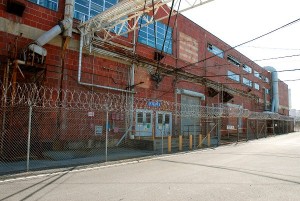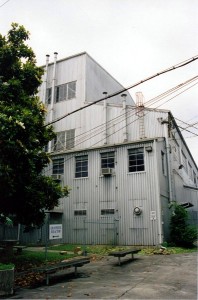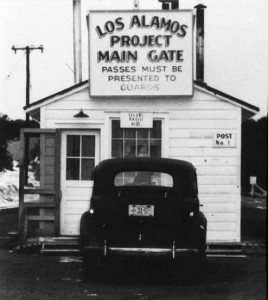Note: This story was last updated at 8:30 p.m.
WASHINGTON, D.C.‚ÄĒThe¬†U.S. House of Representatives has passed a bill¬†that would create a Manhattan Project National Historical Park that would include Oak Ridge,¬†federal officials said Thursday afternoon.
Passage of the bill, pursued for years by historic preservationists, was announced by U.S. Senator Lamar Alexander and Representative Chuck Fleischmann, both Tennessee Republicans. It was an amendment to the National Defense Authorization Act, or NDAA, which passed in a 300-119 vote.
The bill would designate three sites that were part of the World War II-era Manhattan Project. Besides Oak Ridge, the sites include Los Alamos, New Mexico, and Hanford, Washington. The U.S. Senate is expected to pass the 2015 NDAA legislation without amendments before adjourning for the Christmas recess, perhaps as early as next week, according to the Atomic Heritage Foundation, a Washington, D.C.-based nonprofit that has helped lead efforts to establish the park for more than a decade.
The Manhattan Project was a top-secret federal program to build the world’s first atomic bombs. Oak Ridge sites that would be included in the park are the¬†Beta-3 racetracks and Alpha Calutron magnets at Y-12 National Security Complex and the K-25 Building site at the East Tennessee Technology Park.
‚ÄúThe Manhattan Project is one of the most significant events in American history, and this legislation will protect and preserve these sites, including those at Oak Ridge, and designate them as a national historical park,‚ÄĚ Alexander said. ‚ÄúOak Ridge continues to serve as a global resource for scientific discovery, and this national historical park will provide the opportunity to learn about the significance of the Manhattan Project and how it continues to shape our history.‚ÄĚ
The Atomic Heritage Foundation said the national park designation would ensure that historic Manhattan Project sites are preserved for the American public and future generations. The legislation provides an inventory of properties and historic districts to be included in the park. Besides the uranium-enriching facilities in Oak Ridge, the park would include the first-of-a-kind B Reactor at Hanford and the buildings where the first atomic bombs were assembled at Los Alamos.
The legislation establishes the park no later than one year after enactment.

Building 9204-3 at the Y-12 National Security Complex could be among those included in a Manhattan Project National Historical Park. (Photo courtesy of Y-12 National Security Complex.)
“Consistent with this, the U.S. Departments of Energy and Interior have one year¬†to enter an agreement defining respective roles and responsibilities and addressing how to enhance public access, preserve historic properties, and interpret the history for the public,” the Atomic Heritage Foundation said.
As the nation’s storyteller, the National Park Service will be responsible for interpretation.
‚ÄúThe National Park Service is committed to engaging visitors and telling controversial and difficult stories in ways that illuminate and respect different experiences and perspectives,”¬†Associate Director Stephanie Toothman told the¬†Atomic Heritage Foundation.
The bill allows the Secretary of Energy to accept donations to the park, an important clause in light of limited federal funds, the Foundation said.
“This will enable donors and volunteers who have already expressed interest in contributing to the preservation of Manhattan Project properties to do so,” it said.

Pictured above at a June 28, 2012, U.S. House hearing on the Manhattan Project National Historical Park Act are, from front left, Cindy Kelly, Atomic Heritage Foundation president; Heather McClenahan, executive director of the Los Alamos Historical Society; and D. Ray Smith, Y-12 National Security Complex historian. Gary Petersen, Tri-City Development Council vice president, is pictured in the background. (Photo courtesy of Atomic Heritage Foundation.
Fleischmann said the Manhattan Project produced groundbreaking achievements at a critical time in the nation‚Äôs history and the “legacy of the incredible work done in the three cities deserves to be recognized.
“The advancements achieved by thousands of hard-working men and women at Oak Ridge helped bring an end to World War II,” Fleischmann said. “The Manhattan Project continues to serve as one of the most significant accomplishments in American history, and I am proud that our legislation will honor these facilities by designating them as a National Historical Park.‚ÄĚ
The Atomic Heritage Foundation said the Manhattan Project National Historical Park will be one of the few parks to focus on American industry and highlight the work of physicists, chemists, engineers, mathematicians, and other scientists.
“The park could become a catalyst for teaching about science, technology, engineering, and math (STEM) and increasing America’s understanding of the nexus between science and society,” the Foundation said.
It said the legislation, which has passed the House before only to get tied up in the Senate, has been in the works for a long time. In 2003, Congress required the U.S. Department of Energy to develop a plan for preserving its Manhattan Project history. Under a cooperative agreement with DOE, the Atomic Heritage Foundation took on the task, beginning with a series of public meetings at Oak Ridge, Los Alamos, and Richland, Washington, that included National Park Service representatives. AHF’s report released in 2004 recommended a Manhattan Project National Historical Park at the three major sites.
In September 2004, Congress passed the Manhattan Project National Historical Park Study Act (PL 108-340) that authorized the National Park Service to study whether to create a Manhattan Project National Historical Park. In July 2011, the National Park Service and the Department of Energy jointly submitted recommendations to Congress for a park with units at Los Alamos, Oak Ridge, and Hanford.

Building 9731 at Y-12 could also be included in the Manhattan Project park. The Manhattan Project was a top-secret federal program to build the world’s first atomic weapons during World War II.
The Manhattan Project National Historical Park Act was introduced in 2012. Its champions in the House have been Fleischmann and representatives Doc Hastings, a Washington Republican, and Ben Ray Lujan, a New Mexico Democrat. In the Senate, they have been Alexander, and senators Bob Corker, a Tennessee Republican; Maria Cantwell and Patty Murray, both Washington Democrats; and Tom Udall and Martin Heinrich, both New Mexico Democrats. Earlier champions included former New Mexico senators Jeff Bingaman and Pete Domenici.
The Atomic Heritage Foundation said it has worked on the project in partnership with the Manhattan Project communities, National Parks Conservation Association, National Trust for Historic Preservation, and Energy Communities Alliance.
“The House passage today is an important milestone,” the Foundation said.
Don Barger, Southeast regional director for the NPCA, said there is a lot of bipartisan support for passing the bill. There aren’t that many pieces of legislation that Congress has to pass before the recess, he said.
“I think the prospects (of passage in the Senate) are very good,” Barger said.
The Manhattan Project National Historical Park is part of a large package of parks bills that would result in the largest expansion of the national park system in decades. Barger said there is a lot of pent-up demand because Congress has not passed many parks bills in the past five years.
‚ÄúI just think that this is long-overdue for the significance of the Manhattan Project to be recognized within the park system and for the park system to be able to maintain and tell that story,” Barger said. “Other than the war that the Manhattan Project helped end, I don‚Äôt know that there is any more significant event in the 20th century.‚ÄĚ
The NDAA legislation can be found here. The Manhattan Project Park provision is on pages 1245-1257.
See previous story here.

The X-10 Graphite Reactor at Oak Ridge National Laboratory. (Photo courtesy Atomic Heritage Foundation)

Now demolished, the former mile-long, U-shaped K-25 Building, pictured above, was once used to enrich uranium for atomic weapons and commercial nuclear power plants. Located in west Oak Ridge, the site could become part of a Manhattan Project National Historical Park. (Photo courtesy of U.S. Department of Energy)



Susan Gawarecki says
This is great news! Bill Wilcox would be very happy. Let’s hope that there is no reason for this section of the NDAA to get removed in conference or the larger legislation vetoed due to partisan politics.
johnhuotari says
Susan, you’ve probably seen the news that the Senate has also passed the bill, but here’s our story in case you haven’t: http://bjq.6af.mytemp.website/2014/12/12/senate-passes-manhattan-project-park-bill-includes-oak-ridge/